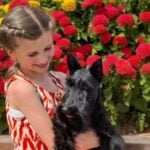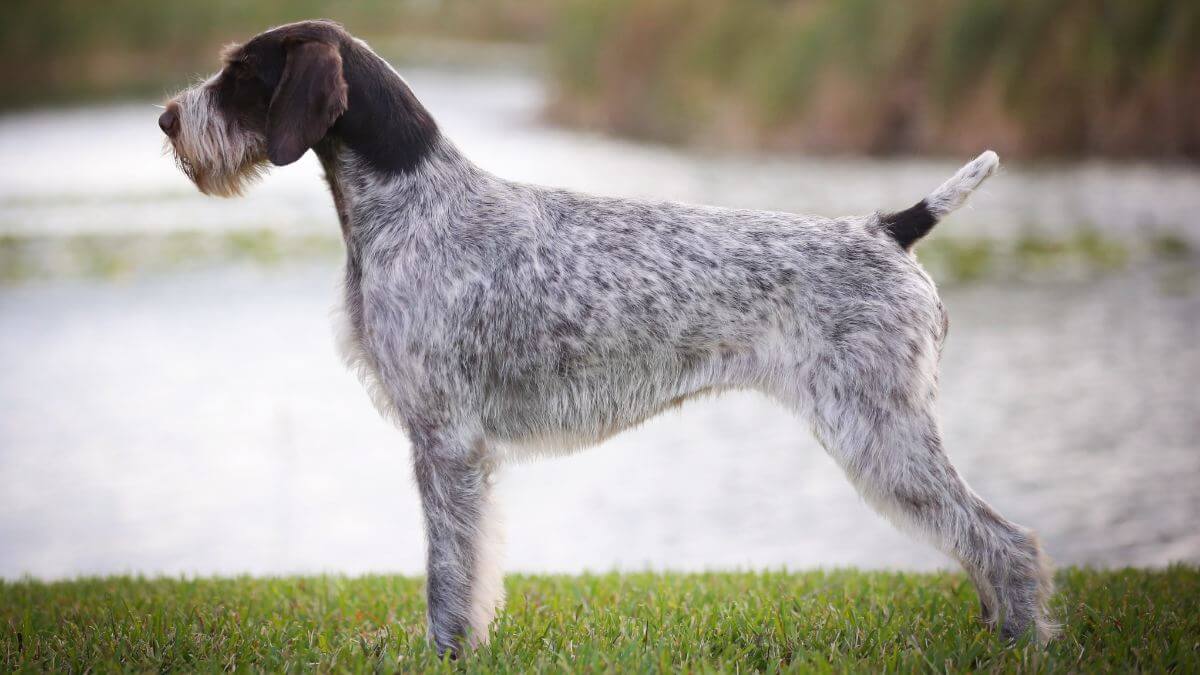
Home » Judging the German Wirehaired Pointer

This article was originally published in Showsight Magazine, April 2013 issue.
The German Wirehaired Pointer is first and foremost a versatile hunting dog. It was developed by a pragmatic people to find game, point it, and retrieve it on both land and in water and to blood track wounded game as well. Its quarry was varied and ranged from upland birds and waterfowl to rabbit, fox, and roe deer. The terrain that these dogs hunted was diverse and besides versatility, adaptability was a key goal in its development. In this breed, a good percentage of the dogs that you’ll see are in some way utilized in the field. Therefore, prioritizing by function is the most positive way that you can judge. The essence of the breed is a rough-coated, athletically built, versatile hunting dog—practical, low maintenance, efficient.
Many judges don’t see significant numbers of German Wirehaired Pointers. This, in itself, makes it a difficult breed for some to evaluate. Additionally, it’s often misrepresented as a German Shorthaired Pointer with a rough coat and furnishings—it is, rather, a breed onto itself and not, nor was it ever, a “variety.” Our standard, just like many other Breed Standards, doesn’t always present a crystal clear picture of its intent, and interpretation can be difficult. There are also no disqualifications in our standard. That doesn’t mean that “anything goes” or that no matter how much an individual dog deviates from the standard, it should be awarded championship points.
When a class of German Wirehaired Pointers enters the ring, get a first impression of the dog that you’re judging. The silhouette of the dog should be immediately identifiable as a GWP. Is the outline pleasing, is the dog balanced, is there substance without coarseness? Do you get the impression of athleticism and good capacity for muscling? As you put your hands on the dog to evaluate him, remember that this dog should be sound, both physically and mentally, and functional. “Function” is the key to all aspects of the standard. For example, if you have a dog with a light eye and one with a soft, open coat, keep in mind that the dog can see with an undesirable-colored eye, but cannot be protected in dense, harsh cover or in cold water with a bad coat. Approach the dog from the front so that it can see you and confidently put your hands on him. Wirehairs usually have a strong sense of self and their personal space. Not a breed you should stare at or “coo” at!
From the side, the head should give a rectangular appearance, the impression of two rectangles with parallel planes and relatively equal length. Facial furnishing (beard and eyebrows) should be present to be protective, but not overdone. Eyebrows should appear natural and are never scissored—GWPs should not be trimmed to look like terriers or Giant Schnauzers. Don’t necessarily penalize a dog for sparse facial furnishings, as very often excellently coated dogs do not have abundant furnishings. Remember that the coat on the dog’s skull should be naturally short and close-fitting. The ears are rounded at the tips, not too broad, and hang close to the head, and should be set just above the level of the eye. The correct bite is scissors and complete dentition is preferred. When examining a dog’s mouth, there’s no need to count teeth, but large gaps should be noted. The jaws are strong and should be sufficiently deep to carry game.
The eyes are brown and slightly oval in shape. A dark eye is very pleasing and adds to the correct expression of the dog. Although we have dogs with lighter eyes in the breed, we are rarely seeing the yellow “bird of prey” eyes that were more common years ago. A young dog may have a lighter eye with a darker ring around the iris. They will darken over time, sometimes taking up to three years to achieve their adult color. Eye rims should be close-fitting to keep out irritating seeds, grasses, and other debris. The nose is brown, never black or flesh-colored.
The neck is slightly arched and should have enough length and strength for the dog to retrieve and easily carry a good-sized pheasant or goose. Proportionately, the body from the sternum to ischium is slightly longer than from withers to ground. The forechest is defined, with the brisket extending to the elbow, enabling good heart and lung capacity. Although the chest is developed, it shouldn’t be so wide as to interfere in any way with the action of the forelegs. The back is short and strong with a perceptible slope from withers to croup. Perceptible means that you should be able to recognize that there is a slope, it doesn’t mean exaggerated. Ribs are well sprung and the underline extends well back to form a gradual tuck-up, which is apparent. The croup is gently rounded, showing no tendency to fall away sharply, and the tail is a continuation of the spinal column and should be carried at or above the horizontal when the dog is moving and alert. The entire outline of the dog should flow smoothly.
Although the standard calls for the tail to be docked to approximately two-fifths of its original length, this is often a personal preference, and the docked length is obviously man-made. The length of a docked tail is not a reason to ever fault an otherwise good dog. The feet of a GWP are webbed and slightly oval in outline, with toes well arched and close. A tight foot with good depth of pad protects the dog from stones, sand spurs, burrs, thorns, and other hazards on the ground while hunting. Shoulders should be well laid back with hindquarter angulation balancing that of the front. Good angulation facilitates a smooth, ground-covering stride and balance of those angles enables correct foot timing and promotes endurance in a dog that is working. The gait is harmonious, effortless, and purposeful and the topline should remain firm when the dog is moving. The standard mentions that the “leg bones are flat, rather than round,” in reality, the bone is oval, not flat.
The natural functional double coat is the hallmark of the breed. The standard states that “a dog must have correct coat to be of correct type.” The coat is weather-resistant and to some extent, water-repellent. The outer coat is straight, harsh, wiry, and flat-lying. It is long enough to protect the dog against the punishment of rough cover, but not so long as to hide the outline of the dog. The coat on the skull and ears is naturally short and close-fitting, however, the ears may have wisps of longer hair or a “fringe.” The undercoat is softer and shorter and may be dense enough in winter to insulate against the cold but may be quite thin in summer—but, undercoat should always be present to some degree.
Leg furnishings should not be excessive and should have some wiry texture. The hair in the liver body patches may be shorter than the rest of the outer coat. The correct puppy coat may be shorter than that of an adult coat but will show some signs of the coarse texture. The coat on this breed was originally intended to be “wash and wear,” designed by a pragmatic people who would not be bothered with a high-maintenance coat. However, there are many inconsistencies in coat type and texture. It is not uncommon to see a smooth coat, which is incorrect. A shorter, harsh coat with wiry texture and evidence of guard hairs is perfectly acceptable. Soft, wooly, or cottony coats are not protective and should be penalized as they tend to attract dirt, burrs, and seeds and are detrimental in water. Coats should not be clippered or scissored, as there should be no need for it. Bad coats can be trimmed and made to appear quite acceptable, but a judge can only evaluate what is presented. Excessive grooming to present a dog artificially is truly not desirable in this breed.
The color of the dog is liver and white and may have roaning, ticking, or patches; it may also be solid liver, sometimes with a white blaze on the chest or some amount of white on the feet. “Liver” can vary in shade from chocolate to dark seal brown and can appear almost black in certain lighting. A liver and white or solid liver dog will always have a brown nose, as required by the standard. Although the standard says that “any black in the coat is to be severely penalized,” a liver or liver and white dog with any black in its coat has not been seen and is likely not genetically possible. If the dog has a brown nose, it is assured to be liver and white without black in its coat. A black and white dog will have a black nose and is not included in our standard, though it is acceptable in some other countries. The head and ears are required to be liver, but a blaze on the head is acceptable, provided that the color around both eyes is liver. Discoloration in a dog’s beard due to sun or saliva should not be faulted. Judges should always be aware of the dog’s color and remember that the standard calls for a liver and white dog.
Temperament is sound and reliable. A German Wirehaired Pointer may be aloof to strangers and initially cautious. This caution should not be confused with shyness. Temperament should always be sound, and aggression toward people should never be tolerated. Breeders of German Wirehaired Pointers have made every effort to keep bench and field dogs unified as “one breed.” Considering the total number of registered dogs, there is a large number of Dual Champions and dual-titled dogs. There have been several Dual Champion Best in Show dogs, and it is not unusual for a Dual Champion to win the GWPCA National Field Championship. Wirehairs have become contenders in both the show ring and field trials. Judges can support this endeavor by keeping the breed’s working qualities in mind when evaluating dogs.
Above all, please avoid fault-judging. Standards often point out faults and areas to be penalized without emphasizing positive characteristics. Consider the dog as a whole and remember that the goal is to continue to produce dogs capable of fulfilling their original purpose—to hunt long, hard, and intelligently.